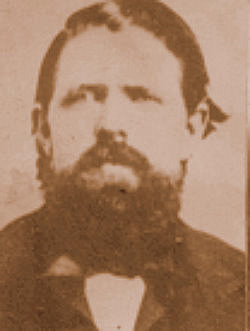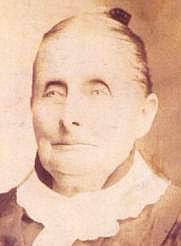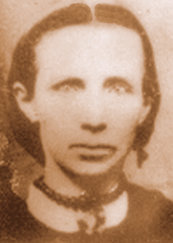Lately there has been a lot of interest in pioneers and their stories and since Andrew Quigley, formerly of Ireland and Farmington, Utah, was an early citizen of Clarkston, he and two of his families can be considered as Pioneers in that community.
 Andrew Quigley ca. 1870 |
Andrew Quigley (1831-1881)
Andrew Quigley was born in Willmount, Tyrone Co., Ireland about 1831 and came to America about 1849, then came to Utah in a wagon train headed for California in late summer of 1852. Wintering in Farmington, he worked for a prominent LDS family, the Hector Haight family. He converted to the LDS Church, married Elizabeth Miller and they started their first mission in 1853, a six-month mission in Sanpete Co. Two years later in 1856, Andrew was married to his second wife Harriet Yates. The following year, he was among the third group of missionaries called to Fort Lemhi in Idaho where he became a good friend of Israel J. Clark who later became a founder of Clarkston and for whom the town was named and who probably encouraged Andrew in the move to Clarkston.
By late 1866, Andrew had decided to reunite his first two families. His family of Elizabeth and their six children were still living in Farmington while Harriet and her three living children had been residing in Calls Fort, near Brigham City for about two years. Since the summer of 1864 Andrew had been in a partnership with William Carbine herding stock, including sheep, in northern Utah and southern Idaho and started his third family in 1866 and they lived in Oxford, Idaho. It seems that Andrew did not have much contact with his Farmington family during this time and he surely missed them.
There is no clear indication of when Andrew moved his first two families to Clarkston in the family records that have been kept, but it seems probable that they moved there in the latter part of 1866 when this partnership with William Carbine was dissolved. An entry in the records of the 40th Quorum of Seventy, of which Andrew was a member in Farmington, states in February of 1867 that he then had residence in Cache Co. so the move was probably made a short time before then.
 Elizabeth Miller Quigley |
 Harriet Yates Quigley |
In Clarkston he probably built or had built, a large home for his two families as the 1870 Census shows them all living in the same household. By 1868, according to Ben and Eunice Ravsten in their book “HISTORY OF Clarkston The Granary of Cache Valley” the family was fully involved in the church and community there and his wife Elizabeth was called to be the 2nd Counselor at the organization of the Relief Society in August 1868 (p. 98) and Andrew involved in many church and community activities. Andrew was appointed as Justice of the Peace for about a year from about August 1869 (see p. 4) and his old friend and former partner, William Carbine, was the Constable in Clarkston during this same time, the next year William Carbine became Andrew’s brother-in-law with his marriage to a sister of Elizabeth named Sarah Jane Miller.
In May of 1869 at the organization of the Coop Store, Andrew was chosen as the treasurer and a director, (“History of Clarkston” p. 5). Some time after this Andrew and two others were appointed to purchase a sawmill (p. 6). This is the same sawmill that is mentioned in Newton’s history and was for sale. This sawmill was run by water power but since the creek seldom had enough water in it from the mountains west of the valley this sawmill was useless most of the time. In the elections of 1870, Andrew was appointed as a Magistrate (p. 7 & 8). The 1870 Census of Clarkston (FHL 553109) lists Andrew, a “Farmer” with Real Estate valued at 550, with his two wives, 12 children and 2 workers on the farm.
Here in Clarkston, Andrew’s family became larger with four more children by his first wife and four by his second wife between 1868 and 1873. By this time his family had no doubt outgrown that first house and a second one was built for Harriet and her smaller family. At the organization of “The Farmer’s, Gardener’s and Fruit Growers Club” in March 1871, Andrew was chosen as one of the two directors (p. 44) and about 3 years later he was appointed as 1st Vice President at the organization of the Branch of the United Order in Clarkston in June 1874 (p. 10). It was probably shortly after this that Andrew traded his Clarkston property for the Swan Lake, Idaho property where he spent the rest of his life. He traded properties with Russell K. Homer who was the father-in-law of Martin Harris Jr and when the Quigley family moved out of the home occupied by Elizabeth and her children, Martin Harris Jr then moved into this home from Smithfield, bringing his family and his father Martin Harris Sr, with him. This is the same Martin Harris who was one of the witnesses to the Book of Mormon plates, the Angel, etc. and where he testified of its truthfulness on several occasions before he died.
In the aforementioned book “History of Clarkston…” (p. 167) the author quotes from a letter to him by former resident of Clarkston, George Godfrey, who was then living in Fielding. Speaking of Martin Harris Sr he says: “He was at Quigleys for some time until the Quigleys moved to Swan Lake and then moved to William Carbines and died…” etc. but this leads a person to believe that the Quigley family was still living there at that time which is not the case. An account by Andrew’s son, Alma M. Quigley, written when he was 89 yrs old, says when he (Alma) was 12 ½ years old he met Martin Harris while in the company of Sol Harris, another son of Martin. This meeting took place in late 1874 when the two Martins were living in the house that his mother (Elizabeth) had vacated. He further stated that “this was the first and only time I ever saw him.” From this statement, now in the hands of some of Alma’s living grandchildren, we can be sure that by late 1874 the family of Andrew Quigley had moved to Swan Lake and there they had to build additional housing for Harriet and her children before they could move.
The legacy of Andrew Quigley in the valley still lives on since two of the almost twenty canyons in the Clarkston Mountains to the west of the valley bear his name as the “Old Quigley Canyon” and the “New Quigley Canyon.” There is also a crossing of the Clarkston Creek called the “Quigley Crossing” at the north east corner of Newton, where Andrew was given property, but he was among those who decided to stay in Clarkston and not make the move to Newton in 1869/70. The name of the creek has since been changed to Newton Creek and there is a culvert there to make crossing easier but it is still known as Quigley Crossing by the residents and is shown on some maps that are available.
When Andrew moved his first family to Swan Lake in 1874, he started to build a log cabin for his second family and his oldest son was mortally injured when one of the logs used in constructing this cabin slipped and fell on him and he died shortly after in January 1875. Andrew later helped build a sawmill near Swan Lake and when the railroad was built through there he sold some of his property to the railroad agent and helped in its building with ties from the sawmill and also made sawn lumber for the building of another house two-stories high for his first wife and children, where my grandfather was born. His 2nd wife Harriet died about a year before Andrew in April 1880 before the 1880 Census was taken. Andrew died in a SLC hospital of cancer in May 1881 from the long term effects of carrying a bullet in his shoulder and would never have it removed. Both of the SL newspapers had articles about him as he was a friend to many leaders of the church up to that time and had done much to help with the Indian problems. Andrew was a close friend of Chief Arimo for over 25 years and could speak their language. The 1st wife Elizabeth lived on until Jan 1915 when she joined her husband in death.
--Written and adapted from the larger, A History of Andrew Quigley and His Three Families, by William A. Quigley, a great grandson.